Ever wish you could read your customers’ minds right after they interact with your business? Transactional NPS (tNPS) comes close, capturing real-time feedback after key moments—whether it’s a purchase, support call, or any critical touchpoint.
It’s like catching your customers’ thoughts while they’re fresh so you can make quick improvements that really matter.
Net Promoter Score (NPS) is incredibly versatile—it can be measured after any transaction or on a regular schedule, giving you valuable insights at any point in the customer journey.
tNPS is more than just data—it’s your go-to tool for zeroing in on what’s working and what’s not.
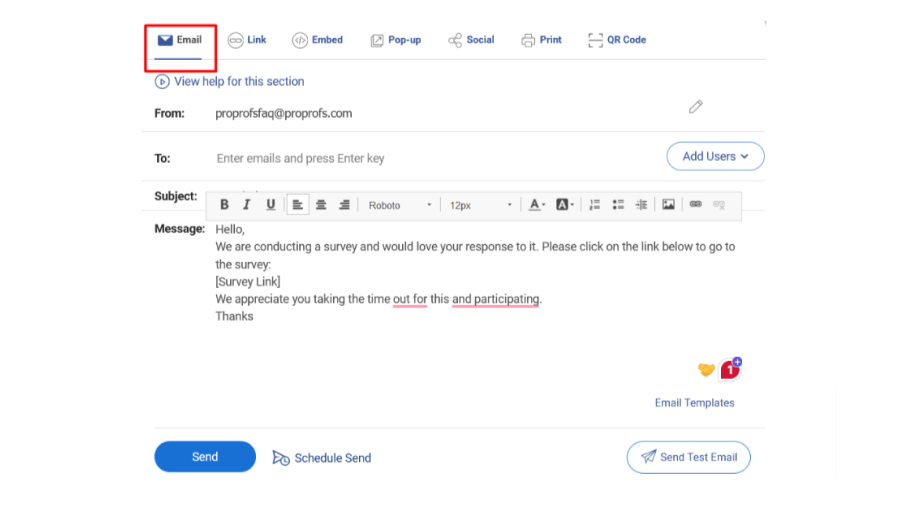
Pair it with relationship NPS (rNPS), and you get a full view of customer loyalty, both up close and over time.
Ready to see how these two NPS types can supercharge your customer strategy? Let’s dive into how transactional NPS fits into the bigger NPS picture.
What is Transactional NPS?
Transactional NPS is a specialized form of net promoter score that focuses on specific customer interactions.
Unlike broader NPS surveys that capture overall customer sentiment, tNPS focuses on the immediate aftermath of a particular transaction—whether that’s a purchase, a support interaction, or any other touchpoint that matters in your customer journey.
If you want to know how well your support team handled a recent issue or how satisfied customers are with their latest purchase, tNPS surveys can provide the insight.
The real power of tNPS lies in its ability to highlight areas of improvement. It’s the tool you need to make quick, effective changes based on real-time customer feedback.
Related Read: A Complete Guide on Net Promoter Score (NPS)
What is Relationship NPS?
Relationship NPS measures the overall sentiment your customers have toward your brand rather than focusing on specific interactions. It’s your go-to metric for understanding long-term loyalty and customer satisfaction.
Typically, rNPS surveys are sent out at regular intervals, giving you insights into how your customers perceive your brand over time.
You can use rNPS when you want to gauge the health of your customer relationships and track trends in loyalty. It’s especially valuable for businesses that depend on repeat customers or long-term engagements, helping you make informed decisions that strengthen your overall customer base.
Difference Between Transactional and Relationship NPS Surveys
Transactional NPS gathers feedback right after specific interactions, making it ideal for immediate improvements. On the other hand, relationship NPS provides insights into overall customer loyalty, helping you understand long-term trends.
Here’s a more detailed comparison:
| Aspect | tNPS | rNPS |
|---|---|---|
| Focus | Specific interactions | Overall relationship |
| Timing | After a key transaction | Regular intervals (e.g., quarterly) |
| Survey Frequency | Frequently, after each interaction | Less frequent (e.g., annually) |
| Insights | Immediate and actionable | Strategic and long-term |
| Objective | Address specific issues | Track overall brand perception |
| Best For | Short-term fixes | Long-term strategy |
Using both tNPS and rNPS together provides a comprehensive view of customer satisfaction, allowing you to tackle both immediate challenges and long-term goals.
Relationship NPS vs Transactional NPS: Which One Should You Choose?
Deciding between relationship NPS and transactional NPS depends on your specific goals. Both serve valuable purposes, but the choice depends on what you need to measure.
Choose rNPS if your goal is to understand your customers’ overall loyalty and sentiment. This is particularly useful for tracking trends over time, benchmarking against industry standards, and making strategic decisions that impact your entire customer base.
Choose tNPS when you want immediate, actionable feedback on specific interactions. This approach is best for identifying and addressing issues at particular touchpoints, such as after a purchase or customer service interaction, ensuring that you can make quick adjustments to improve customer satisfaction.
For most businesses, the ideal approach is to use both. By combining rNPS and tNPS, you can gain a complete understanding of your customers—balancing immediate improvements with long-term strategies.
FREE. All Features. FOREVER!
Try our Forever FREE account with all premium features!
What are the Types of Transactional NPS Surveys?
When it comes to transactional NPS, there are several key moments in your customers’ journey where gathering feedback can make all the difference. These surveys give you immediate insights right after those crucial interactions. Let’s break it down into a few common types:
Post-Purchase Surveys
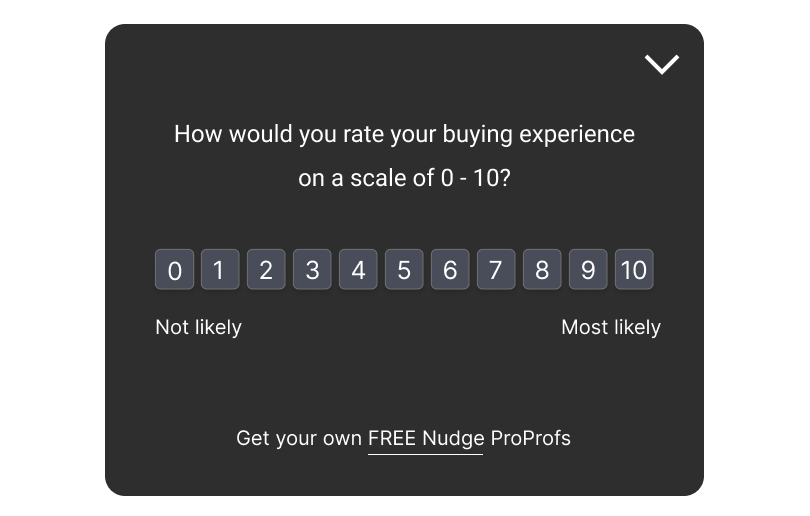
Ever wonder what your customers really think right after they’ve bought something? That’s where post-purchase surveys come in.
You send these out after purchase to get the lowdown on how the buying process went, how they’re feeling about the product, and whether they’re satisfied overall. It’s a great way to catch any issues early and keep your customers happy.
Read more: Post-Purchase Surveys: What Is It, Methods and Questions
Customer Service Interaction Surveys
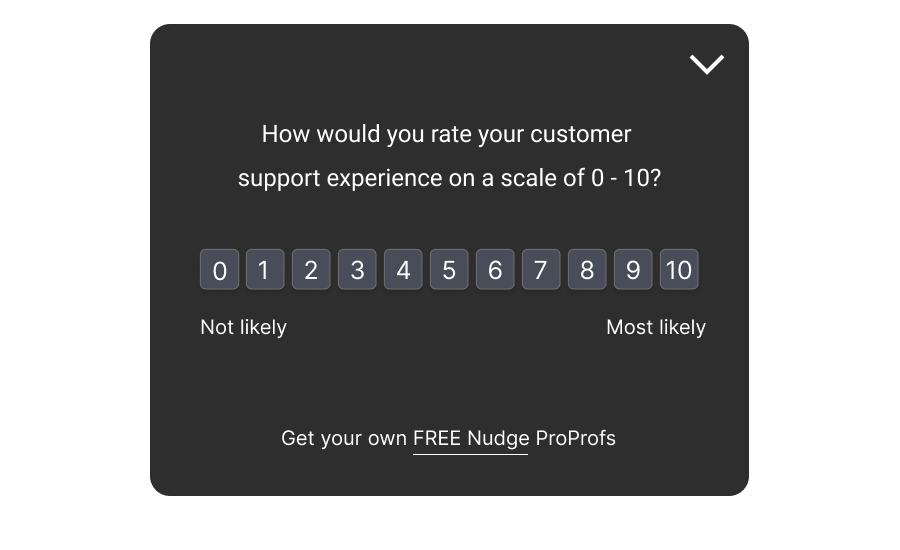
We all know that support interactions can make or break a customer’s day. These surveys go out after a customer has contacted your support team—whether through chat, email, or a call. It’s your chance to see how well your team handled the situation and where there might be room for improvement.
Product/Feature Update Surveys
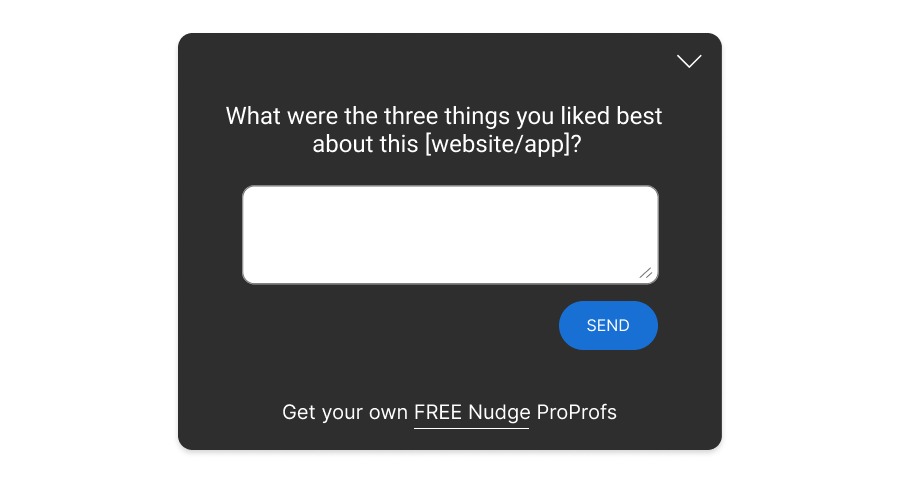
Just rolled out a new feature or product? This is your opportunity to hear from customers after they’ve had a chance to try it out. Are they loving it, or are there issues that need fixing? This product feedback helps you fine-tune things before small problems become big headaches.
Check out: 100+ Free to Use Product Feedback Survey Questions
Onboarding Surveys
Onboarding is huge for first impressions. This survey checks in with your new customers to see how their onboarding experience went. Was it smooth? Did they feel supported? Getting this right can be the difference between a loyal customer and one who churns.
It also allows you to provide personalized onboarding to your customers, further improving retention.
Post-Event Surveys
If you’re hosting events, webinars, or training sessions, post-event surveys are your go-to for feedback. They help you understand what worked and what didn’t so you can make the next event even better.
Each of these tNPS surveys gives you a snapshot of how customers are feeling at critical points in their journey, helping you make improvements that matter.
When Should You Send tNPS Surveys and rNPS Surveys?
Deciding when to send transactional NPS and relationship NPS surveys depends on the kind of insights you’re after. Let’s break it down:
Transactional NPS surveys should be sent right after a key customer interaction—whether it’s a purchase, a support call, or any other significant touchpoint.
The goal here is to capture fresh feedback while the experience is still top of mind for your customers. Timing is crucial because you want their immediate reaction, which helps you address any issues quickly.
Relationship NPS surveys, on the other hand, are best sent at regular intervals—like quarterly or annually. These surveys aren’t tied to a specific event but are designed to gauge the overall health of your customer relationships over time.
By spacing them out, you get a broad view of customer loyalty and can track how it changes year over year.
In a nutshell:
- tNPS: Send right after an interaction for instant feedback.
- rNPS: Send at regular intervals to monitor long-term sentiment.
Using both approaches strategically ensures that you’re not only reacting to immediate needs but also keeping an eye on the bigger picture.
Best Practices for Using Transactional NPS Surveys
To get the most out of tNPS surveys, follow these best practices:
Choose the Right Touchpoints
Not every interaction needs a survey. Focus on the moments that matter most to your customers—like after a purchase, a support interaction, or a significant product update. These are the times when feedback is most valuable.
Time It Right
Timing is everything with tNPS. Send the survey as soon as possible after the interaction while the experience is still fresh in your customer’s mind. This ensures you get accurate and relevant feedback.
Related Read: When Is the Best Time & Day to Send a Survey
Keep It Short and Simple
Customers are more likely to respond to a survey that respects their time. Stick to a few key questions—like the NPS question, followed by an open-ended one. This keeps the process quick while still giving you actionable insights.
Here’s an example:
NPS Question
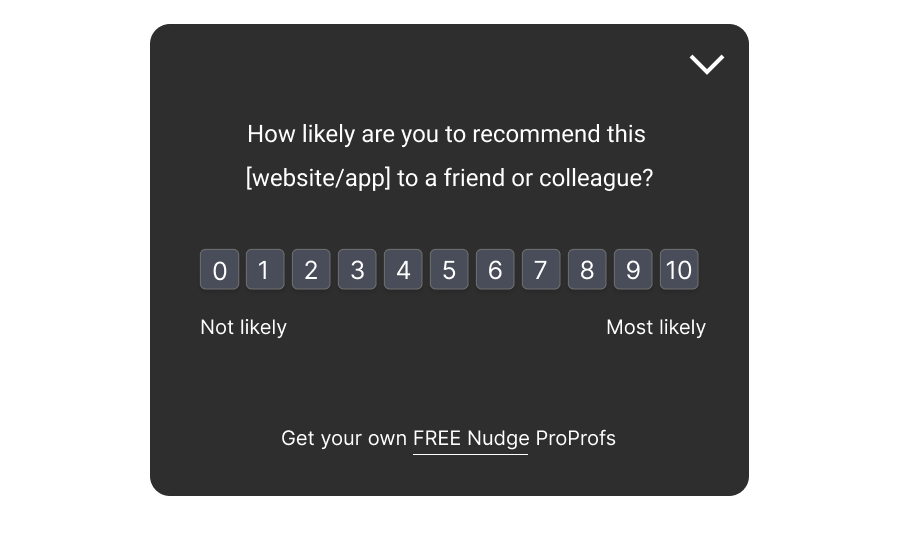
Follow-up Question
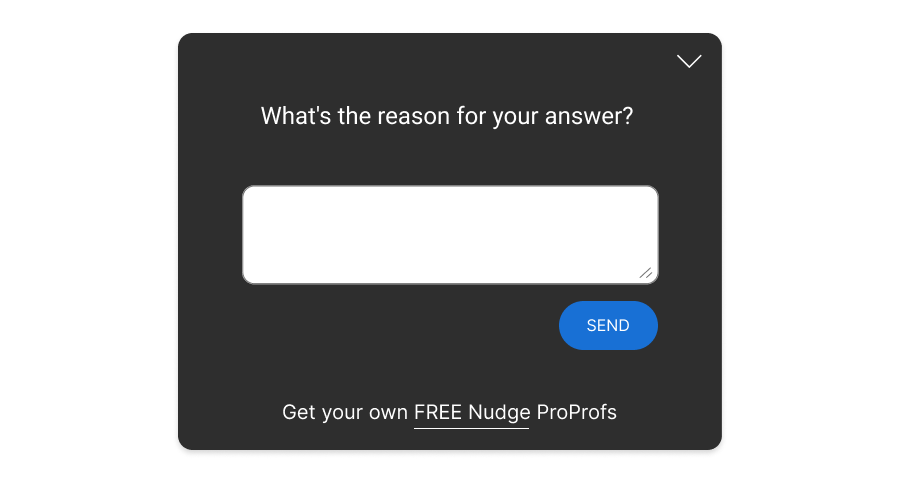
Act on the Feedback
Collecting feedback is only half the battle. Make sure to close the loop by acting on what you learn. If a customer reports a negative experience, reach out to resolve the issue. This not only improves customer satisfaction but also shows that you value their input.
Related Read: Customer Feedback Loop: What Is It & Best Ways to Close It
Use Automation
Automating your tNPS surveys ensures they’re sent at the right moment without manual effort. Set up triggers for specific interactions so surveys go out automatically, keeping the process seamless and timely.
Read more: 10 NPS Survey Best Practices
By following these best practices, your tNPS surveys will be more effective, helping you quickly identify and address issues while keeping your customers happy and loyal.
Examples of Transactional NPS Survey Questions
When crafting tNPS surveys, it’s essential to ask the right questions to get meaningful feedback. Here are some examples that can help you gather valuable insights:
Post-Purchase Example
“Based on your recent purchase of [Product/Service], how likely are you to recommend our company to a friend or colleague?”
This question drills down to a customer’s immediate experience with their purchase, helping you understand their satisfaction with the buying process and the product itself.
Customer Service Interaction Example
“After your recent interaction with our support team, how likely are you to recommend our services to others?”
This question is perfect for assessing the effectiveness of your customer service, highlighting areas where your team excels or where improvements are needed.
Onboarding Example
“How satisfied are you with your onboarding experience, and how likely are you to recommend our service to others?”
For new customers, this question helps you gauge how well the onboarding process meets their needs and whether it sets the right tone for the rest of their journey with your company.
Product/Feature Update Example
“After trying out the new [Feature/Product], how likely are you to recommend it to others?”
When launching new features or products, this question lets you know if the update is hitting the mark or if adjustments are needed.
Post-Event Example
“Following the [Event/Webinar/Training], how likely are you to recommend our events to your peers?”
This question is useful for gathering feedback after hosting events, ensuring that future events can be fine-tuned to meet participant expectations better.
These tNPS survey questions are designed to be direct and easy to answer, while also providing you with actionable feedback that can help improve specific touchpoints in the customer journey.
FREE. All Features. FOREVER!
Try our Forever FREE account with all premium features!
What to Do With Transactional NPS Data
Collecting tNPS data is only the first step. The real value comes from what you do with that data. Here’s how to turn your tNPS insights into actionable improvements:
Analyze the Feedback
Start by categorizing your respondents into Promoters (scores 9-10), Passives (scores 7-8), and Detractors (scores 0-6). This segmentation helps you understand overall customer sentiment at specific touchpoints.
Identify Trends
Look for patterns in the feedback. Are there recurring issues or consistent praise for certain aspects of your service? Identifying trends can point you toward areas that need attention or opportunities to replicate success.
Close the Loop With Detractors
For customers who fall into the Detractor category, reach out promptly. Address their concerns, offer solutions, and show them their feedback matters. This proactive approach can turn a negative experience into a positive one, improving customer retention.
Leverage Positive Feedback
Don’t forget about your Promoters! Encourage them to share their positive experiences through testimonials, reviews, or referrals. This can help boost your brand’s reputation and attract new customers.
Share Insights With Your Team
Make sure the feedback doesn’t just sit in a report. Share the insights with relevant teams—whether it’s customer service, product development, or marketing—so they can take action. Real-time feedback should lead to real-time improvements.
Track Progress
After implementing changes based on tNPS data, continue to track your scores over time. Are the improvements making a difference? Regularly reviewing your data helps ensure that you’re moving in the right direction and continuously enhancing the customer experience.
By actively working with tNPS data, you can turn feedback into a powerful tool for improving customer satisfaction and loyalty.
How to Calculate Net Promoter Score Using Qualaroo
Qualaroo simplifies the process of calculating your NPS by providing intuitive tools for gathering and analyzing customer feedback. Here’s how you can efficiently calculate and leverage NPS with Qualaroo:
Step 1: Deploy NPS Surveys Across Multiple Channels
With Qualaroo, you can easily distribute NPS surveys across your website, mobile apps, or via email. This ensures you capture customer feedback at the most relevant touchpoints, whether it’s post-purchase, after customer service interactions, or during key moments in the user journey.
Read: Mobile App Survey: A Complete Guide
Step 2: Collect Responses and Categorize Automatically

Once the surveys are deployed, Qualaroo categorizes responses into promoters, passives, and detractors automatically. This real-time segmentation streamlines the process, allowing you to focus on the data rather than the manual sorting of responses.
Step 3: Calculate NPS With a Simple Formula
Qualaroo automates the NPS calculation by using the formula: NPS = (% Promoters – % Detractors) x 100. The platform also offers advanced reporting tools that display these calculations in real-time on the dashboard, providing actionable insights through data segmentation and trend analysis.
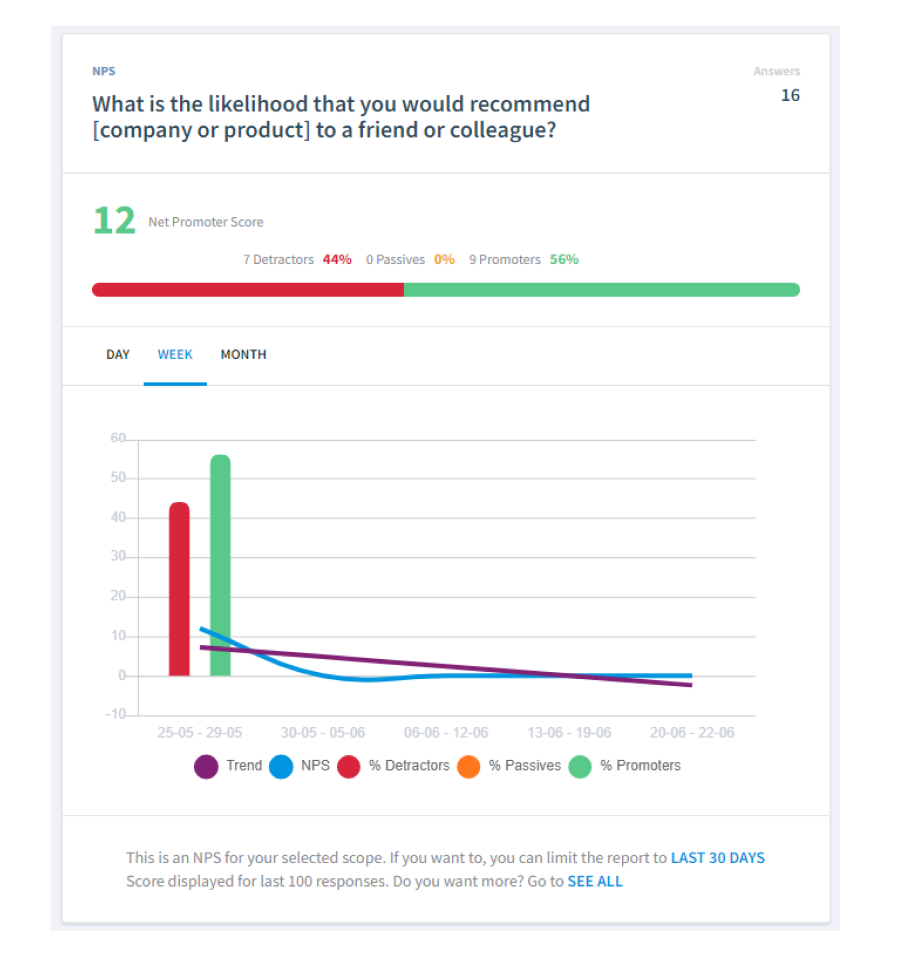
Step 4: Analyze and Act on the Data
Qualaroo’s advanced analytics tools help you track your NPS score over time and dive into the details. With real-time reporting and AI-powered sentiment analysis, you can identify trends, uncover issues, and prioritize areas for improvement.
Step 5: Monitor and Improve
By continuously monitoring your NPS with Qualaroo, you can stay ahead of potential issues and capitalize on opportunities to improve customer satisfaction. The platform allows you to track the impact of your actions, ensuring that your strategies are effectively enhancing the customer experience.
How to Collect Transactional and Relationship NPS
Collecting both tNPS and rNPS is straightforward when you have the right tools in place. Here’s how you can gather both types of feedback efficiently:
Transactional NPS Surveys
For tNPS, timing is everything. Make sure to send the survey right after the interaction—whether it’s a purchase, a service call, or any other key moment. The goal is to capture feedback while the experience is still fresh.
- Timing: Send immediately after the interaction.
- Method: Use email, in-app, or on-site surveys to reach customers right where they interact.
Relationship NPS Surveys
With rNPS, you’re looking to gauge overall sentiment over time. Schedule these surveys periodically to get a sense of customer loyalty and brand perception.
- Timing: Regular intervals, like quarterly or annually.
- Method: Email campaigns or in-app surveys work best for reaching a wide audience.
Using Qualaroo for Both
With Qualaroo, setting up both types of surveys is easy. You can deploy surveys across multiple channels and take advantage of Qualaroo’s targeting features to ensure the right customers see the right surveys at the right time.
- Multi-Channel Deployment: Reach customers on websites, mobile apps, or through email.
- Advanced Targeting: Use Qualaroo’s features to target specific audiences based on behavior or other criteria.
By incorporating both tNPS and rNPS into your feedback strategy, you’ll have a complete picture of your customers’ experiences and loyalty.
Watch: How Twilio Leveraged Qualaroo’s Behavioral Insights to Drive Product Success
Elevate Your NPS Strategy With Actionable Insights
Integrating tNPS and rNPS into your feedback strategy is more than just collecting data—it’s about transforming that data into actionable insights that drive real change.
tNPS allows you to stay agile, addressing specific customer interactions in real time, while rNPS helps you see the bigger picture, building long-term loyalty and trust.
But data without action is just noise. That’s where Qualaroo shines. With its precise targeting, real-time analytics, and seamless integration across platforms, Qualaroo turns your NPS data into a roadmap for growth. Whether you’re fine-tuning a product experience or strengthening customer relationships, Qualaroo gives you the tools to confidently move forward.
Why wait? Start using Qualaroo today to gather feedback and turn it into your competitive advantage. Your customers are talking—Qualaroo helps you listen and act.
If you’re just getting started, Qualaroo’s free plan offers a great way to explore its powerful features without any upfront commitment. You can begin collecting insights, better understanding your customers, and making informed decisions that drive growth—all at no cost.
Frequently Asked Questions
What is the difference between transactional NPS and CSAT?
Transactional NPS measures customer loyalty after a specific interaction, asking how likely customers are to recommend the company. Customer Satisfaction (CSAT) measures immediate satisfaction with a product or service. While tNPS focuses on long-term loyalty, CSAT captures short-term, experience-based contentment.
What are the three categories of NPS?
The three categories of NPS are:
- Promoters (score 9-10): Loyal customers who are likely to recommend your product or service.
- Passives (score 7-8): Satisfied but unenthusiastic customers who could switch to competitors.
- Detractors (score 0-6): Unhappy customers who may spread negative word of mouth.
FREE. All Features. FOREVER!
Try our Forever FREE account with all premium features!
 We'd love your feedback!
We'd love your feedback! Thanks for your feedback!
Thanks for your feedback!



